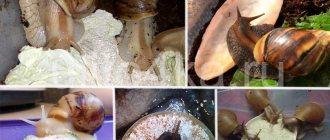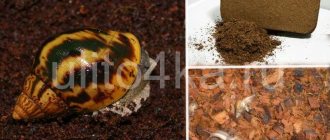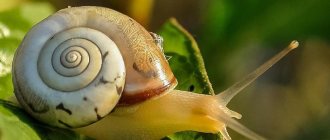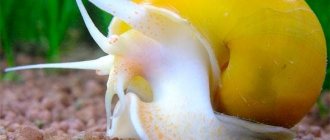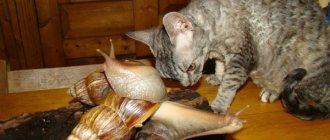Lighting
Akhatina has poor vision; she only distinguishes between day and night. Therefore, it is not necessary to install lighting in the snail's terrarium or container. This is more needed for monitoring two-horned pets and plant growth. Only the incandescent lamp needs to be taken outside the container or aquarium so that the snail does not get burned.
Temperature and humidity content
All Achatina are residents of tropical countries, so the optimal temperature for keeping them is considered to be from 24 to 28 degrees. At very high air temperatures, snails feel unwell, hibernate and may even die. There is no need to place snails on the windowsill or near the radiator.
Many snail breeders use thermal mats or a thermal cord, since the room temperature for a mollusk is very low. However, heating devices must be placed on the outside of the container. Humidity is also a prerequisite for a snail to live comfortably.
The humidity in the terrarium is maintained by daily irrigation of the soil, as well as by placing a shallow container of water. To determine humidity, a hygrometer is placed in the terrarium, but sphagnum moss can successfully replace it. If it is green and the snails are not constantly on the walls of the container, then everything is in order with humidity. If the moss turns yellow, the air needs to be humidified.
Temperature regime for small snails
During the first few months, it is important to maintain a constant temperature and humidity in the terrarium with small snails. To do this, place a thermometer and hygrometer. The optimal temperature for keeping Achatina is 25 - 27 degrees. Optimum humidity 65% - 70%. A thermal cord or incandescent lamp will help you maintain the temperature. Humidity - daily spraying with boiled water from a spray bottle.
Decorating the terrarium
Branches, driftwood, pieces of bark, moss, coconut halves, etc. are used as natural materials for decorating the terrarium. I also plant indoor plants and seeds in the ground for landscaping. Snails quickly eat green shoots, thereby replenishing the body with vitamins.
However, we decorate the terrarium for ourselves; the snails do not need this for a normal life.
Priming
For newborn Achatina leaves, lettuce and cabbage are usually used as soil. The kids sit on these leaves and eat, gaining strength. If small snails are in a terrarium with soil, then give preference to fine coconut substrate and flower soil without fertilizers. It is better to avoid moss in the first months. Sand, stones and sawdust are strictly prohibited as soil. Which soil to choose.
Breeding the Achatina snail (Reproduction of Achatina snails)
Achatina snails are hermaphrodites, that is, each individual has both male and female genital organs. In the absence of a partner, self-fertilization is possible, but it is quite rare.
The snail can store sperm for two years after mating, using it to fertilize maturing eggs. The number of eggs in a clutch is about 200 (in some cases up to 500); the snail can lay 5-6 clutches annually. The size of one egg is 4.5-5.5 mm, its shape resembles that of a chicken. Egg development is possible at temperatures from 22°C and lasts from several hours to 17 days.
Feeding baby snails
For the first few days, newborn Achatina feed on the remains of their eggshells. Therefore, it is enough to put a few lettuce leaves generously sprinkled with ground shells or edible chalk.
The taste habits of the Achatina snail are formed from childhood. Try to diversify the daily diet of your small pets.
In the first week, babies' diet should include grated vegetables, chopped greens, calcium mixtures and grain mixtures. Calcium is necessary for growth and formation of a strong and beautiful shell. Plant protein helps healthy shellfish grow and develop faster. More recipes for nutritional supplements for rapid growth.
From the second week of the snail’s life, add grated fruits and animal protein to its usual diet. Starting from one month of age, replace grated vegetables and fruits with chopped cubes and plates. Read more about feeding babies here.
From the age of two months, snails can be fed with all foods, like adult mollusks.
Do I need to give water to little Achatina?
After each meal, it is advisable to spray the walls of the terrarium with purified or boiled water. The kids will crawl along the wet walls and drink droplets of water. It is advisable to do this in the evening. There is no need to place a separate container of water for snails to drink. Until the kids grow up, it is enough to irrigate the terrarium daily.
If midges appear in a container with small snails and you don’t know how to fight them, read here.
Do not feed small Achatina with viscous and soft food, they can get stuck in it, bury themselves and suffocate.
African snail - features of keeping at home
Initially, the Achatina snail lived only in Africa, but gradually the Achatina beauties became widespread in other territories and continents. For example, in Korea, Achatina is used for cosmetic purposes, and in Japan, African snails are farmed for food. In some countries, Achatina are considered pests: mollusks cause damage to agriculture and even eat plaster on residential buildings.
In Russia, giant Achatinas are not common in the natural environment due to the unsuitable climate. But as pets, African snails have gained enormous popularity and distribution.
The shell of an adult Achatina can reach 23-26 cm, and the body - 29-31 cm. The gastropod has organs such as the heart, kidneys, it even has a brain and eyes, which are located at the ends of the antennae-tentacles.
But there are no ears, so when caring for Achatina, you need to take into account that she cannot hear anything. In addition, Achatina is sensitive to light; it perceives it in the cells of the entire body. Therefore, she does not like bright lighting.
Protective functions are assigned to the shell - it protects against drying out, dangers from the outside, and has an intricate color, which in some cases can change depending on what the Achatina snail ate.
What should be the care for Achatina? As already mentioned, caring for and maintaining Achatina snails is not difficult at home. Some people even keep shellfish in a tank that is damaged, because it will not need to be filled with water. Even a plastic box can be suitable as a house, but due to its opacity it will make it difficult to observe the pet.
What you definitely shouldn’t use to keep a slow-moving pet are cardboard boxes. Achatina can chew through paper and escape.
We recommend purchasing high-quality terrariums, as well as soil, heating, humidifiers and decor on the Aliexpress website. This is proven quality and good prices.
Cleaning a terrarium with snails
Uneaten food and feces should be removed every day. If this is not done in a warm, humid environment, midges, mold and bacteria quickly grow. Then an unpleasant odor appears and parasites may appear. The snails themselves have no smell; the smell is of decaying food debris. When cleaning a terrarium with small Achatina, carefully inspect uneaten lettuce and cabbage leaves before throwing them in the trash. Sometimes babies can sit on them.
Time of maturation of egg laying
You will need preparation to create a good environment for the newborn snails. Therefore, you need to know how long it takes for Achatina snails to hatch from eggs?
Under good conditions, after about 12-14 days, small Achatina snails will hatch from the eggs.
Newborn snails are tiny, delicate and almost transparent. Akhatina babies have such a fragile and thin shell that you can see their heart beating through it. If the snails hatch in their parents' terrarium, it is advisable to place them in a smaller container.
Attention! It is not recommended to handle small Achatina snails. This can cause irreparable harm to the crumbs and they will stop growing. It is advisable to use a plastic spoon to take the newborn snails along with the soil and move them to the nursery terrarium.
Popular types of Achatina
The most common species and the easiest to care for is the Achatina fulica species. The shell of these snails is distinguished by its variegated color, which changes its color depending on the diet. The snail's body may be brownish or brown in color with pronounced tubercles on the skin of the mollusk. Achatina fulica is slow and melancholy; she likes to relax a lot in a cozy corner of the terrarium.
Another common type of snail for home keeping is the reticulata. Its representatives are distinguished by a peculiar pattern on their shells in the form of dots or stripes. Body color is dark brown or black. Snails of this species are more sociable, they are mobile and curious, often raising their heads, wanting to examine what is happening.
Menu and diet Achatina
Feeding Achatina is a simple matter, but you should follow some rules:
- despite the fact that in their homeland snails ate not only plant food - softened, decomposing parts, but also meat, aquarium inhabitants eat greens, fruits and vegetables;
- among Achatina there are often picky eaters, so you should immediately accustom your pets to food variety and ensure that they eat what is offered to them. For example, if the diet of a small “Akhatinka” consists of lettuce and fresh cucumbers, subsequently the individual will refuse other food;
- small mollusks need to chop their food, but large ones can be given large pieces;
- It is not recommended to give “babies” a banana, ripe apricot or peach - they are able to climb into them and may choke;
- baby snails are given carrot or apple puree, finely chopped or passed through a blender. A little later, you can diversify your diet with a green salad and fresh herbs.
The Achatina menu can include the following products:
- watermelons, bananas, figs, grapes, strawberries, cherries, plums, apples, sometimes the snail can be treated to pieces of kiwi or avocado;
- fresh cucumbers, bell peppers, spinach, carrots, cabbage - cauliflower, white cabbage, broccoli, Chinese cabbage, etc., potatoes, zucchini, zucchini, pumpkin;
- peas, beans, lentils;
- porridge - cereal is ground to a powdery state, poured with water, infused and offered to pets;
- vegetation – elderberry flowers, chamomile, dandelion leaves, plantain, spring flowers of fruit crops;
- boiled minced meat - meat, chicken, turkey;
- special ready-made diets;
- fermented milk products – without sugar and artificial additives.
It is not recommended to collect plant food for Achatina in areas with unfavorable ecology - near industries, highways, landfills, dirty, dusty roads. The collected flowers and leaves must be thoroughly washed under running water.
Among the products prohibited for Achatina, confectionery products are in first place. In addition, their menu should not include pickles, smoked foods, or dishes with hot herbs and spices.
How to care for little Achatina
Very tiny snails can be planted in an aquarium with lettuce or cabbage leaves and fed with mineral powder. Such conditions will help babies quickly gain the necessary nutrients and calcium, which has a positive effect on their growth rate.
Otherwise, care comes down to caring for the young snails until they get stronger and become independent. It is important to take care of their life during reproduction and puberty.
Pregnancy will exhaust the body of females. If you don't want to lose a few individuals, don't let them mate often.
How to feed Achatina
Adult snails prefer plant foods; it forms the basis of their diet:
- Lettuce leaves of any variety;
- Sweet fruits and berries;
- Peas, corn on the cob;
- Tomatoes, carrots, zucchini;
- Spinach, cabbage;
- Cucumbers.
All products are offered to shellfish in fresh condition. Some representatives of the species are capricious in food, especially in favorable living conditions. Owners will have to observe which treats their pets like best.
Importance of Calcium
It is this element that ensures the hardness, strength and correct shape of the mollusk shell. If a snail has a calcium deficiency in its body, the shell will lose its protective functions, begin to soften and bend, and its original shape will change.
And since the shell is not an independent organ and is connected to other organs and systems, the animal will develop incorrectly, which can lead to its death. You can add any food containing a large amount of calcium to the Achatina diet:
- crushed egg shells;
- a mixture of cereals (oats, barley, soy);
- sesame seeds;
- cheese, milk, cottage cheese.
In addition, it is recommended that Achatina owners prepare caltsekash for their pets, consisting of a mixture of porridge, wheat bran, gammarus, eggshells, biovetan and food for aquarium fish. If you feed small “Akhatinki” with such a mixture, they will begin to increase in size very quickly. Kaltsekash should also be given to pets that have laid eggs - such food will quickly restore the animal’s strength.
Care and conditions of detention
To provide Achatina with comfortable conditions, it is enough to equip a 10-liter warm terrarium. However, such a reservoir is only enough for one individual. And if the owner wants to raise a large snail, later he will need a more spacious container equipped with a lid so that the mollusk does not “go on the run” or other inquisitive pets do not get to it.
It is worth considering the following needs of Achatina:
- A series of small holes should be made in the container to allow oxygen to enter. The bottom of the tank is lined with soil material.
- Achatina adore the aquatic environment, so it is necessary to install a bowl of water or a small container in the terrarium in which the pet will bathe. But you should make sure that the water does not spill - mollusks do not like living in mud.
- Snails do not require special temperature conditions.
- Care should be taken to ensure suitable humidity in the terrarium. If the tank is too damp, the pet will move in the upper part of the tank; if the air is dry, it will often sit buried in the ground. With a normal indicator, the snail begins to be active during the day, crawling throughout the house, and at night wraps up its shell and hides in the ground. To increase humidity, sprinkle the bottom of the container with water.
- It is important to take care of the cleanliness of the “snail house”; it is thoroughly washed weekly. However, if the mollusk has laid a clutch, this event should be postponed. As for humidity, it is not recommended to change it during this period.
Terrarium houses for Achatina
All snails are nocturnal animals. During daylight hours they rest in shelters. Therefore, in artificial conditions, Achatina needs a house. They can serve:
- half a coconut shell;
- bark of tree;
- snag or woven branches;
- as a last resort - a small ceramic flower pot (you need to put wet moss in such a house).
If the snail has nowhere to rest without prying eyes, the mollusk will experience stress. The pet will stop eating and may fall into a state of suspended animation.
Prohibited foods in the diet
The following list will clearly demonstrate what you should not feed Achatina snails. These products are dangerous to the health and life of pets, and most importantly, they can lead to their death or painful, protracted illnesses. Prohibited products include:
- Salt is the white death of the Achatina snail! A few grains of salt can kill 2-3 babies and an adult.
- Food from the people's table! Domestic snails should not eat anything fried, spicy, pickled, sweet or smoked. It is forbidden to feed even on trial, even as an experiment.
- Pasta and any flour products will lead to death. The snail will not be able to digest such heavy food.
- It is not recommended to feed Achatina eggs, even boiled, due to salmonellosis. However, some breeders pamper their pets with this valuable protein product.
- Bitter, hot and sour vegetables are prohibited - onions, garlic, radishes, sorrel, wormwood, tomato tops.
- Citrus fruits are not recommended due to their high acid content.
- It is not advisable to feed potatoes even when boiled!
- Semolina swells greatly and absorbs water, making it difficult for weak, delicate Achatina to digest.
From the two lists given, we can conclude what can and cannot be fed to Achatina snails and how to create a complete daily diet. But it will not be complete without mineral supplements that will provide the delicate Achatina with vital microelements.
What do Achatina eat in nature?
In nature, snails independently determine the norm, as well as what they can eat and what they cannot.
In captivity, Achatina's main food is vegetation. They also eat mushrooms, algae, moss, lichens, bark and tree fruits.
Young snails prefer live plants and fresh fruits. Adults can feed on rotting plants and carrion.
To build and strengthen their shells, snails eat particles of limestone and shells of dead mollusks.
How do giant snails reproduce?
Achatina are hermaphrodites, they have no division according to gender. If the owner is eager to get the offspring of these exotic pets, he only needs to take two mature mollusks. Typically, small young individuals are male, while large adults are female. The fact that the snails are ready to mate is signaled by a white tubercle appearing on the right side of the neck. The process of fertilization occurs internally, after which eggs are laid by both participants in sexual intercourse.
Snails have a very complex system of genital organs. The seminal fluid from one individual enters the body of another slowly, so the fertilization process can take a long time. There are a number of recorded cases where snails stored their offspring in the form of fertilized eggs until they reached the required size and development.
In order for pets to give birth, they need clean soil, water, and a reservoir. In a dirty, neglected terrarium you should not expect small snails from your Achatina. The next laying will confirm the fact that the owner provides his wards with suitable conditions. The fertility of Achatina is amazing - one clutch can consist of either 4 dozen eggs or 3 hundred. On average, a mollusk lays about 150 eggs.
Often individuals delay the process on their own, scattering eggs in different corners of the tank, but more often snails take laying more seriously and keep all the offspring in a warm, cozy place. After a certain period, which can last from 4 days to 4 weeks, the clutch is opened, and Akhatinka babies are born - tender, weak, with a transparent body and a beady shell. At first, they live in the soil layer, feed on the shell, saturating the body with calcium. After 2 days, the crumbs appear on the surface.
Achatina is an interesting inhabitant of the terrarium, which cannot be called boring or familiar. The snail has an original appearance, habits, long-term memory and the ability to recognize its owner, which undoubtedly puts it above other mollusks.





